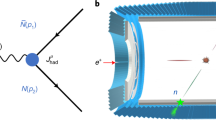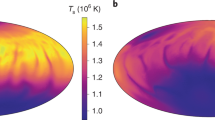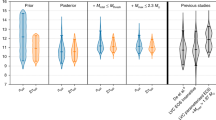Abstract
RECENT advances in the production of large magnetic fields in the laboratory1,2 have generated interest in the effect of intense magnetic fields on various phenomena3,4. The largest field that can be produced in the laboratory1,2 at present is about 106 G, which is considerably lower than the quantum critical field value5 of Hc = m2c3/eV = 4.4 × 1013 G; but the “cosmic laboratory” may be a source of much stronger fields and it has been suggested6 that magnetic fields as large as 1014−1016 G may exist in neutron stars. Hoyle7 has cited the possibility of a large primordial magnetic field, and Brownell and Callaway8 speculate that neutron stars and the dense early universe may be ferromagnetic. One of us (R. F. O.) has examined9 various effects of a large magnetic field and has indicated an effect of magnetic fields which has been often ignored in astrophysical investigations, namely, that the rates of all elementary particle processes will be affected. Pursuing this idea, we examine here the effect of a magnetic field on the β decay rate of a neutron. This is a fundamental process in many astrophysical phenomena and in particular it is very important10 in a problem of current interest, that is, the production of He in the “big-bang” expansion of the universe11. In addition, our calculations should be applicable to other elementary particle processes. We present here only the main ideas ; the calculation details will be published elsewhere12.
This is a preview of subscription content, access via your institution
Access options
Subscribe to this journal
Receive 51 print issues and online access
$199.00 per year
only $3.90 per issue
Buy this article
- Purchase on Springer Link
- Instant access to full article PDF
Prices may be subject to local taxes which are calculated during checkout
Similar content being viewed by others
References
Proc. Intern. Conf. on High Magnetic Fields, Cambridge, Mass. (MIT Press, Cambridge, Mass., 1961); Parkinson, D. H., and Mulhall, B. E., The Generation of High Magnetic Fields (Plenum Press, New York, 1967).
Erber, T., and Latal, H. G., Bull. Amer. Phys. Soc., 10, 1103 (1965).
Erber, T., Rev. Mod. Phys., 38, 626 (1966).
Klein, J. J., Rev. Mod. Phys., 40, 523 (1968).
Landau, L. D., and Lifshitz, E. M., The Classical Theory of Fields, second ed., 9 (Addison Wesley Publishing Company, Inc., Reading, Mass., 1965).
Woltjer, L., Astrophys. J., 140, 1309 (1964).
Hoyle, F., in Onzième Conseil de l'Institut International de Physique Solvay, La Structure et l'Evolution de I'Univers (Editions Stoops, Brussels, Belgium, 1958).
Brownell, D. H., and Callaway, J., Phys. Rev. (in the press).
O'Connell, R. F., Phys. Rev. Lett., 21, 397 (1968); Phys. Lett., 27A, 391 (1968); Phys. Rev., 176, 1433 (1968).
Tayler, R. J., Nature, 217, 433 (1968).
Hoyle, F., and Tayler, R. J., Nature, 203, 1108 (1964). Wagoner, R. V., Science, 155, 1369 (1967). Wagoner, R. V., Fowler, W. A., and Hoyle, F., Astrophys. J., 148, 3 (1967).
Matese, J. J., and O'Connell, R. F., Phys. Rev. (in the press).
Smorodinskiǐ, Y., Sov. Phys. Uspekhi, 67, 1 (1959).
Sokolov, A. A., Introduction to Quantum Electrodynamics (US Atomic Energy Commission: AEC-tr-4322, 1960).
Manley, O. P., Astrophys. J., 147, 808 (1967).
Hawking, S. W., and Tayler, R. J., Nature, 209, 1278 (1966). Thorne, K. S., Astrophys. J., 148, 51 (1967). Zeldovich, Y. B., Sov. Phys. JETP, 21, 656 (1965).
Author information
Authors and Affiliations
Rights and permissions
About this article
Cite this article
O'CONNELL, R., MATESE, J. Effect of a Constant Magnetic Field on the Neutron Beta Decay Rate and its Astrophysical Implications. Nature 222, 649–650 (1969). https://doi.org/10.1038/222649b0
Received:
Revised:
Issue Date:
DOI: https://doi.org/10.1038/222649b0
This article is cited by
-
Constraints on the neutron lifetime from triton β decay
Nature (1984)
-
Nuclear reactions in a cold dense magnetized material
Soviet Physics Journal (1980)
-
Kinetics of neutronization in superdense magnetized matter
Astrophysics (1978)
-
Primordial Helium Production in “Magnetic” Cosmologies
Nature (1969)
Comments
By submitting a comment you agree to abide by our Terms and Community Guidelines. If you find something abusive or that does not comply with our terms or guidelines please flag it as inappropriate.



